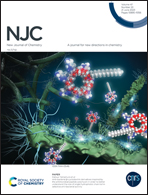Synthesis, characterization, and photocatalytic CO2 reduction evaluation of the CaWxMo1−xO4 (x = 0–1) solid solution†
Abstract
A solid solution with the formula CaWxMo1−xO4 (x = 0–1) was synthesized using a microwave-assisted hydrothermal method. The effect of W6+ concentration was correlated with the solid solution's physicochemical properties. All the samples were characterized to analyze their structural, morphological, optical, and electrochemical properties, corroborating the solid solution formation and the changes caused by differences in W/Mo compositions. The samples grew in different morphologies, varying based on their composition and slightly reducing their bandgap. All solid solution compositions exhibited activity in simultaneous photocatalytic water splitting and carbon dioxide reduction reactions under UV irradiation without a cocatalyst or sacrificial agent. Various products were evolved, with carbon monoxide being the most abundant product generated in most of the samples. The largest amount of carbon monoxide (6.7 μmol) was obtained in the sample with the formula CaW0.8Mo0.2O4, and its superior performance can be attributed to the larger distortion in the cell due to the introduction of W6+ in higher concentrations.



 Please wait while we load your content...
Please wait while we load your content...